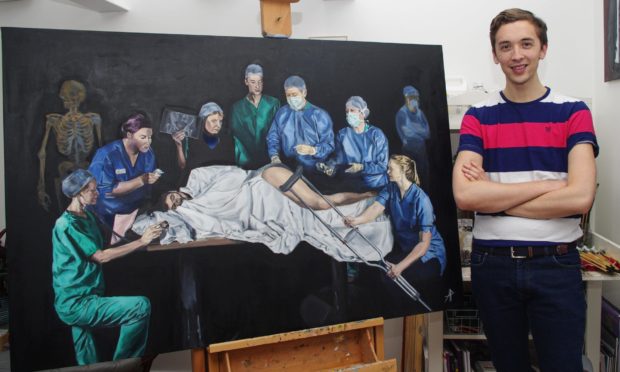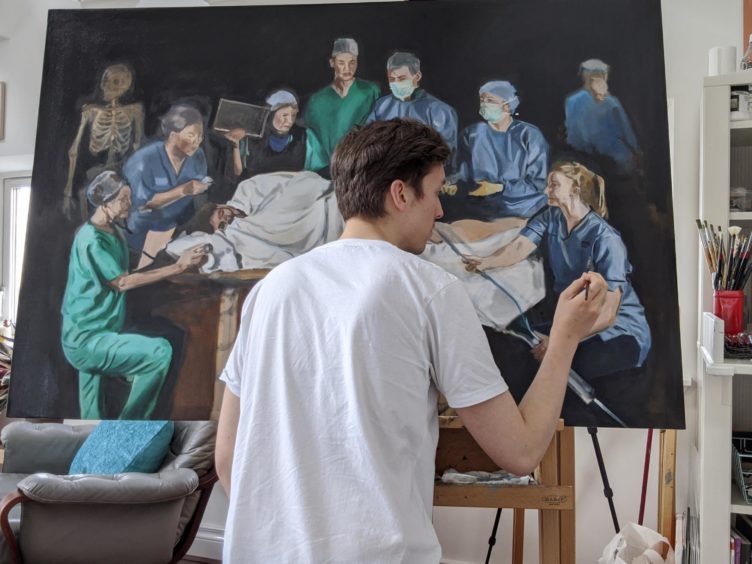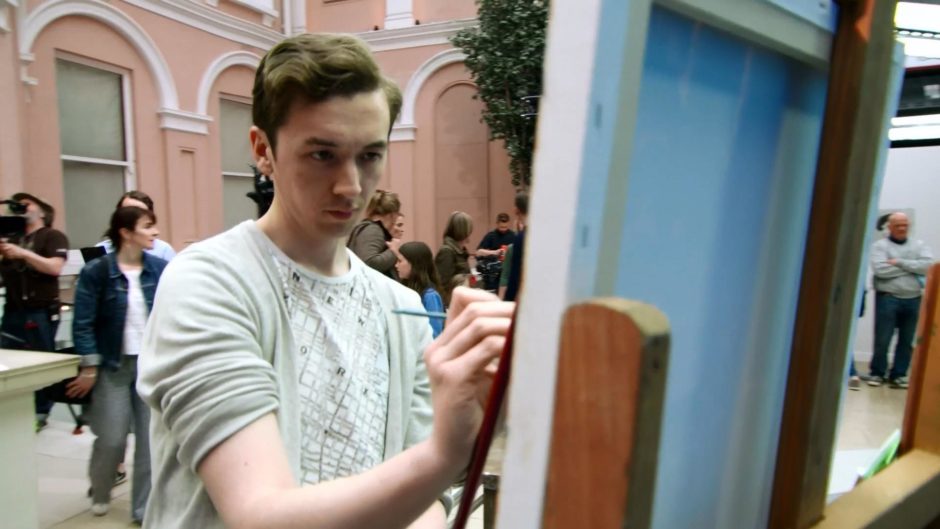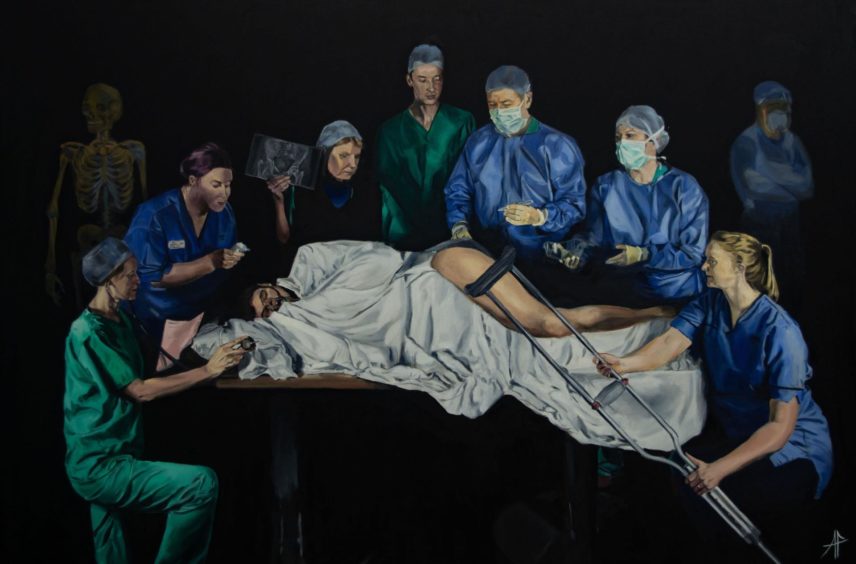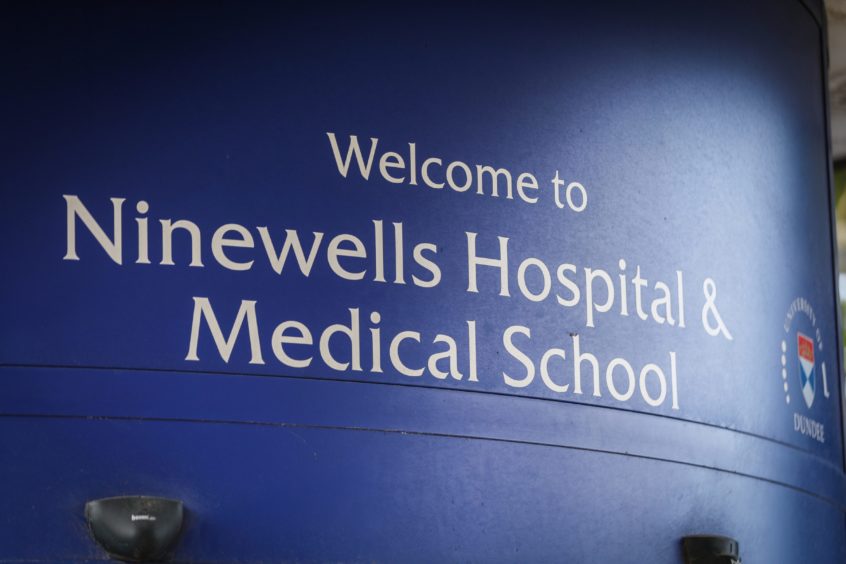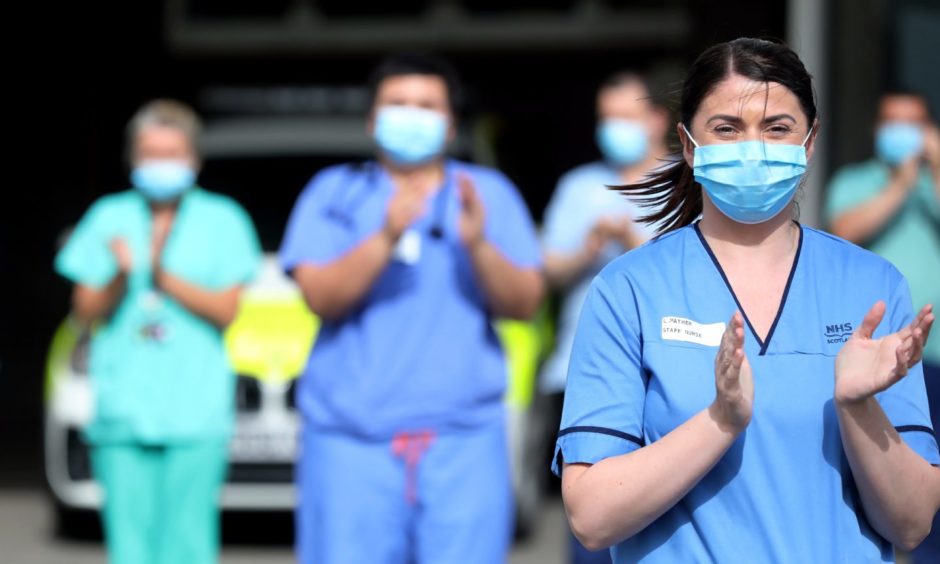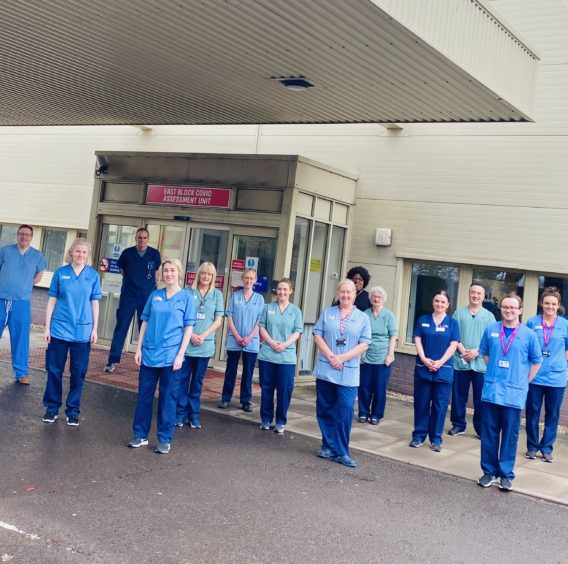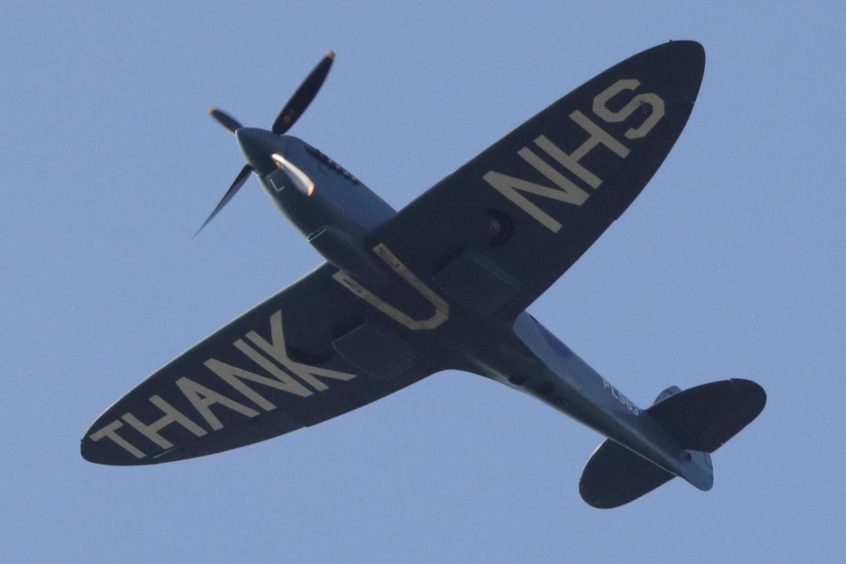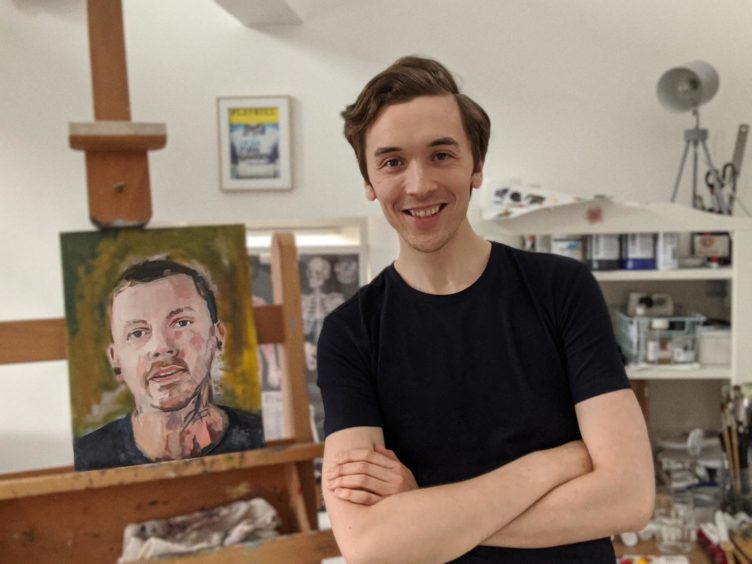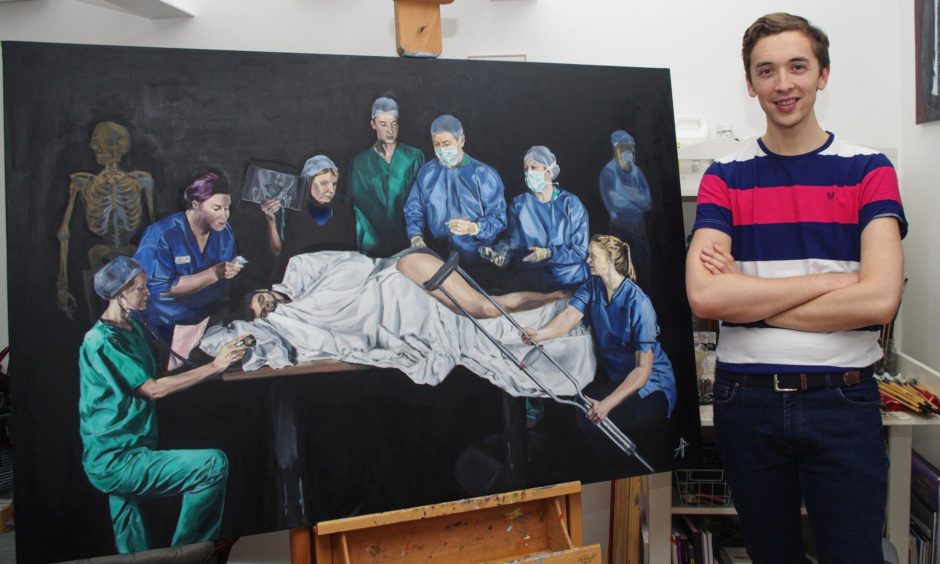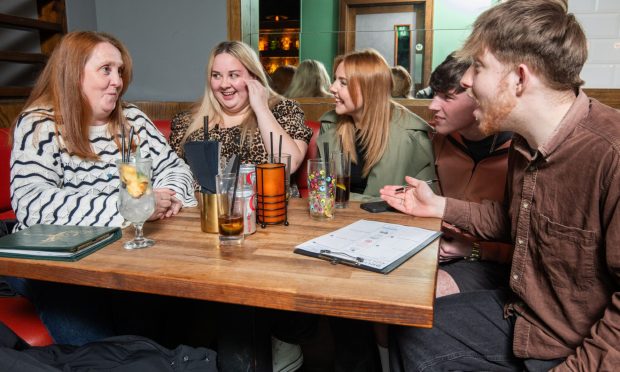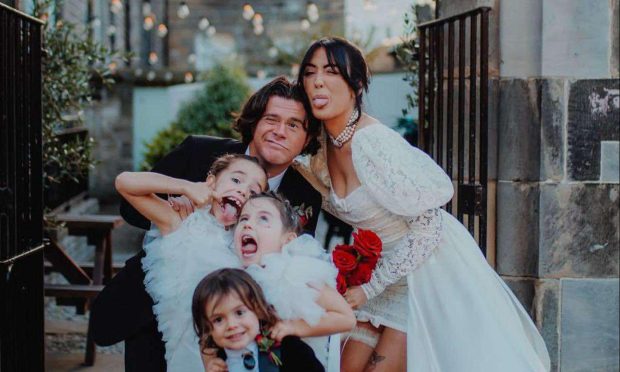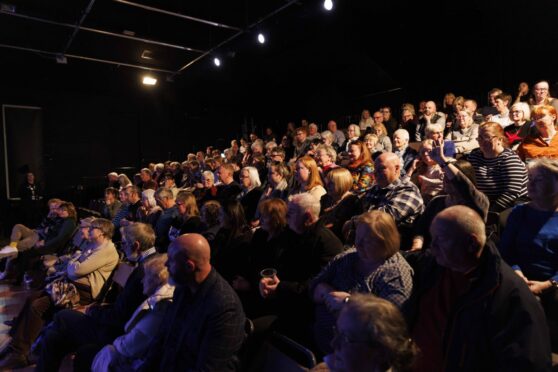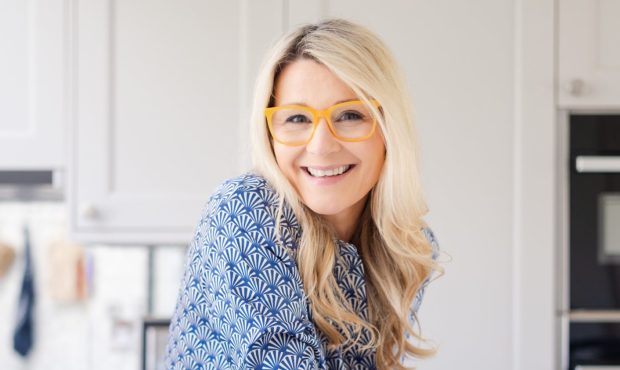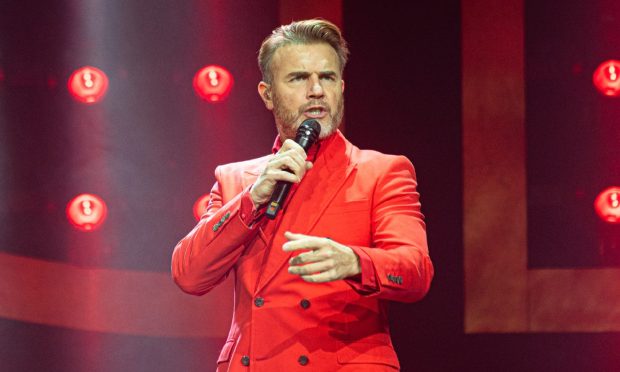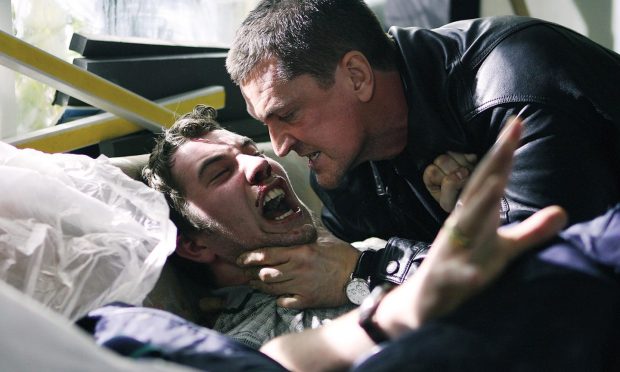As the Covid pandemic continues to bite, Michael Alexander speaks to a Ninewells Hospital surgeon who has painted an artistic tribute to his NHS colleagues during lockdown.
As a trainee trauma and orthopaedic surgeon at Ninewells Hospital in Dundee, Alastair Faulkner is well versed in the art of carrying out complex surgical procedures.
However, as well as finding creative solutions to fixing broken bones, the 32-year-old has also put to use his lifelong love of painting to immortalise his trauma team colleagues during the Covid crisis.
Earlier this year, Alastair painted a group portrait entitled “Trauma” featuring eight frontline health workers, including himself, currently working in NHS Tayside.
It’s been included in an art book called ‘Portraits of NHS Heroes’ that’s gone on sale to raise funds for NHS Charities Together.
How did the book come about?
The Portraits for NHS Heroes initiative was started by artist Tom Croft who paired frontline workers with artists to have their portrait painted for free via Instagram.
The initiative attracted thousands of artists culminating in an online exhibition organised by Paintings in Hospitals.
Alastair first met Croft a few years ago.
They appeared together on a Sky Arts programme called Portrait Artist of the Year, and Alastair has followed him on Instagram ever since.
When the Covid pandemic kicked off in March/April, Alastair noted that Croft was starting his initiative to match artists to NHS workers and record this period.
While he hadn’t started his own painting yet at that point, he’d thought about something similar and, in the context of Covid, thought the initiative sounded great.
A career in art?
“I was a very arty kid at school,” says Alastair who grew up in Rochester, Kent, graduated from Edinburgh in 2012 and did a two year postgraduate placement in Dundee before starting his eight year orthopaedic training in 2015.
“I did consider art as a career. But overall medicine was my calling.
“I guess what put me off, when I was at school was that when I finished my GCSE I found that whole experience quite challenging.
“I don’t think I liked it enough to devote all my time to it.
“Then I developed an interest in a medical career. I thought I have these other skills – I enjoy biology, the idea of medicine really appealed.
“But art never really went away. It sort of lay dormant as it were.
“When I got this orthopaedic training job – a big milestone I wanted to accomplish in terms of my career – I thought ok I probably now have a wee bit more time to do these other things.
“Now I consider art to be as much a part of life as what surgery is.
“It’s about not necessarily making time for it as allowing myself to do it rather than thinking of it as something that should be sacrificed.”
Surgery can be creative
As an orthopaedic surgeon, Alastair deals with the “full range” of broken bone scenarios.
The whole nature of “fixing people” and reconstructing broken bones really appeals to him.
But another aspect of the job he loves is the variety and the fact the team treats everyone from the cradle to the grave.
They see newborns, all the way up to the very elderly and everything inbetween.
“It can be every part of the muscular-skeletal system from the hands to the spine to the hips,” he says.
“It’s a really interesting job. You get everything from the very minor to the very serious.
“You are constantly on your toes and very day brings a new fresh challenge.
“I really like that. I like managing the injuries. The trauma side of things.”
Despite certain procedures having to be followed during operations, there’s also a huge scope for creativity which involves a “cross-over” into art.
“Everything we do is problem solving,” he says, “and with that the need to be creative.
“What I find interesting is that a lot of my colleagues don’t consider themselves to be artistic in the kind of painting and drawing sort of way but I would consider them very creative people.
“That’s just something that people don’t think that they are.
“I’ve done rotation in plastic surgery as well which is extremely artistic in many ways.
“There’s a huge cross over definitely.”
The impact of Covid
The Covid pandemic has certainly had an impact on the orthopaedic team at Ninewells, as it has for the whole NHS.
While the emergency trauma service has continued, Alastair explains that when lock down started, because most people were confined to their houses they did notice a considerable drop in certain injuries.
“We usually expect a higher concentration of kids’ injuries over the summer because everyone is out and about, people on holiday,” he says.
“We didn’t have as many ‘night out’ related injuries – ‘Saturday evening ankles’.
“But we have had a constant stream of frail elderly – broken hips etc.
“I think for us during Covid, we’ve maintained our service but there’s a huge logistical challenge within the hospital.
“We’ve had to move around a lot to accommodate a lot of different pathways, so that’s been more of a challenge.”
Alastair explained that when the trauma team do their operations they wear a certain amount of PPE anyway.
But in the early days of lockdown it was the additional masks that were “were really quite suffocating”.
He adds: “As time has gone on we’ve learned how to manage the risk of the disease.
“We only really need to wear it now for the confirmed positive cases and for cases we don’t know but strongly suspect.
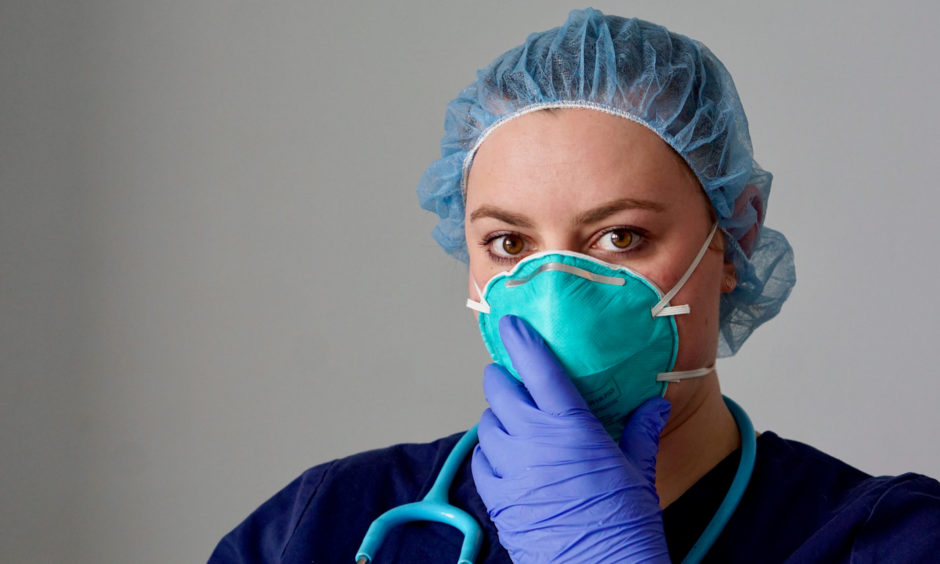
“Thankfully for the vast majority of people who don’t have any symptoms we can still wear our normal PPE.
“But in March, April, May, June it was every single case.”
Alastair said pressures facing other parts of the hospital during the pandemic inevitably have a knock-on effect because everyone is “kind of inter-linked”.
If Covid has really hit the intensive care department quite hard, for example, that has a knock on effect to staffing levels which has a knock on effect to their ability to perform operations and the timings of operations.
Art as a ‘release’
During these challenging times, art has become an even greater “release” for Alastair when he’s off duty.
“Art is for me an environment I have total control over,” says Alastair, who leans towards impressionist painting in terms of style.
“I can be responsible for when I paint, what I paint, how I create the works of art, what features in them. That’s a really good escape from the day job because there’s a lot of stuff I can’t control in the hospital.
“I can’t control the pandemic and what it’s doing to our wards, our patients. That’s very much outside of my control.
“Art is my little way of finding a sense of control in a very chaotic world and what I found doing surgery is it gave me a discipline that I didn’t have before with art.
“With surgery you have to be very focussed on the task.
“In operations for instance you can’t just walk half way through because you don’t like what’s going on.
“You have to finish it and push through with the operation. I very much do that with my art.
“Before I might not have enjoyed painting something because I didn’t think it looks good Actually now I just need to push through, this is fine. Keep going in a really big way.
“I think my experience of surgery has really improved my approach to art. It gave me discipline. I used the skills in both my jobs.”
The painting
Alastair’s painting features Dr Joanna Lynch, consultant anaesthetist; Ms Sarah Cant, advanced trauma Nurse Practitioner; Ms. Lindsey Fulton, senior radiographer; himself – Mr Alastair Faulkner, trainee trauma and orthopaedic surgeon and the artist; Mr Fraser Harrold, consultant trauma and orthopaedic surgeon; Ms Jemma Cathro, surgical charge nurse; Mrs Caroline Hutchison, physiotherapist, and the patient Mr Peter Davies, trainee trauma and orthopaedic surgeon.
Practicing trauma and orthopaedic surgery is about shared decision making between patients, clinicians and the wider team based on experience, teamwork and collaboration which was what he wanted to celebrate.
“I chose a lot of them because they had been supportive of my art in the past,” he smiles.
“They had either commissioned me or bought my art or my prints. I very much felt like they had been part of my artistic journey.
“I got their permission to do it and I think they were all quite thrilled with the outcome.”
And his own thoughts when he saw the finished book?
“I couldn’t really describe it,” he says. “I got goose bumps.
“I’d see paintings on Instagram as they were submitted. Tom Croft uploaded them as they were submitted.
“But to see them all in the one place, all sitting next to each other was quite an emotional situation because I hadn’t really known a lot of the stories of these other artists.
“I think for me to be in that book not just as an artist but as a subject as well is a double honour because it’s the perfect combination of my love of art and my love of surgery.
“I felt enormously privileged.”
*Portraits for NHS Heroes, initiated by Tom Croft, is published by Bloomsbury Caravel at £25. All royalties, a minimum of £2.50 from the sale of each book will be paid to NHS Charities Together (registered charity no. 1186569) to fund vital projects.
